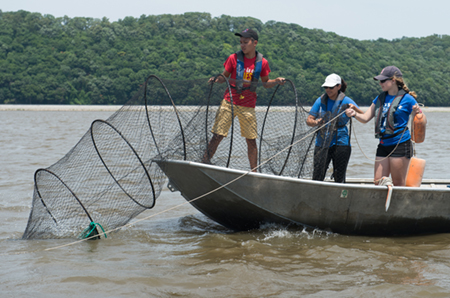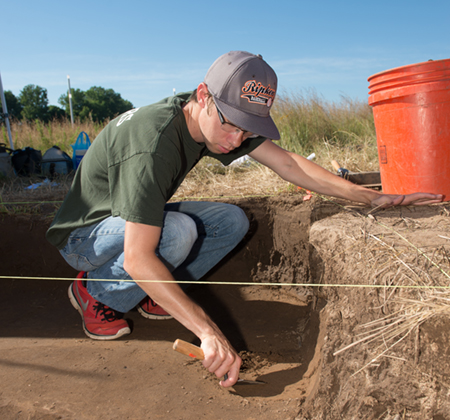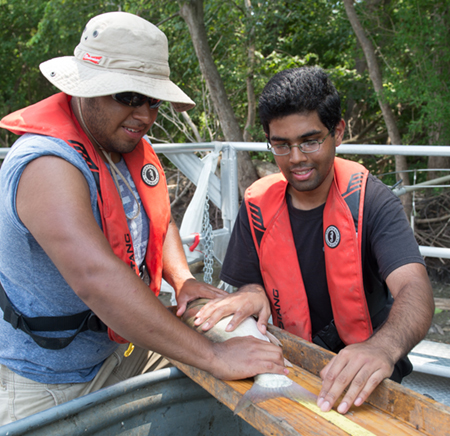 Southern Illinois University Edwardsville’s expansive landscape, featuring archeological sites and close proximity to the Mississippi River, is offering a unique research experience for 10 undergraduates, many of whom are first generation students, from around the country.
Southern Illinois University Edwardsville’s expansive landscape, featuring archeological sites and close proximity to the Mississippi River, is offering a unique research experience for 10 undergraduates, many of whom are first generation students, from around the country.
This summer marked the start of a three-year program funded by a $287,690 National Science Foundation (NSF) Research Experiences for Undergraduates (REU) grant awarded to SIUE and the University of Illinois. The project is entitled Exploring Evidence of the Anthropocene: Archaeological and Ecological Interdisciplinary Research Experiences for First Generation Students in the Upper Mississippi River System.
For eight weeks, undergraduate scholars from such universities as the University of Miami, Boston University and the University of Houston, have been researching evidence of the Anthropocene through interdisciplinary archeological and ecological collaborations at SIUE and the Illinois Natural History Survey.
Their work will be featured during the REU Symposium being held from 1-3:30 p.m. Thursday, July 27 in the Morris University Center Meeting Room A.
“I wanted to be involved in an opportunity that contained both field experience and laboratory work,” said Ayush Kumar, a rising senior studying at Concordia University in Portland, Oregon. “This program offers the best of both and is an experience that all undergraduates should pursue. It’s taken me out of my comfort zone and taught me how impactful conservation efforts are. It’s given me the idea that I want to work with freshwater animals.”
 “In fields like anthropology and ecology, students can really get somewhere if they put themselves out there and pursue experiences like this,” added Christian Rice, a rising sophomore at Southeast Missouri State. “Archaeology is definitely where I want to be, so going to graduate school and doing other field research projects like this are in my future.”
“In fields like anthropology and ecology, students can really get somewhere if they put themselves out there and pursue experiences like this,” added Christian Rice, a rising sophomore at Southeast Missouri State. “Archaeology is definitely where I want to be, so going to graduate school and doing other field research projects like this are in my future.”
Carol Colaninno-Meeks, PhD, assistant research professor in the SIUE STEM Center is the principal investigator (PI). Closely operating the program is co-PI John Chick, PhD, director of the Great Rivers Field Station, U of Illinois Natural History Survey.
The students are engaging in field archaeology and fish-monitoring programs in the Mississippi and Illinois Rivers, and learning methodologies and theoretical perspectives that bridge archaeological and ecological concepts. They’ve spent time advancing knowledge excavating at an archaeological site on SIUE’s campus, as well as participating in fish sampling and water quality monitoring at the Great Rivers Field Station.
“This is a valuable opportunity for these students to work closely with scholars who are using new, innovative approaches to document the onset of the Anthropocene in the region,” Colaninno-Meeks said. “This type of interdisciplinary experience for first generation undergraduates is rarely seen in higher education.
“SIUE’s landscape offers students something they can’t really get on other campuses. The ecosystem and the environmental resources we have, and what the University has done to facilitate archeological research are phenomenal.”
“The Long-Term Resource Monitoring element of the Upper Mississippi River Restoration is likely the most comprehensive and standardized long-term monitoring program for any large ecosystem in the world,” said Chick. “Combining this information with archaeological data on fish remains dating back over millennia presents a unique opportunity to assess human use and potential impacts on great rivers.”
 “Working on a project like this gives students a much greater feel for actual research,” he continued. “A typical field class is great for learning sampling techniques, but it doesn’t allow students to experience the day to day consistency in sampling methodology or the setup and breakdown at the start and end of each day. The students involved in this program will leave with an excellent understanding of what a standardized monitoring or research program is and how it operates.”
“Working on a project like this gives students a much greater feel for actual research,” he continued. “A typical field class is great for learning sampling techniques, but it doesn’t allow students to experience the day to day consistency in sampling methodology or the setup and breakdown at the start and end of each day. The students involved in this program will leave with an excellent understanding of what a standardized monitoring or research program is and how it operates.”
“This has been a good way to explore the options within archaeology and ecology, since I’m not sure what I want to specialize in yet,” said Julia Breed, a rising sophomore at the University of Massachusetts Dartmouth. “Being outside and doing hands-on fieldwork has helped me realize the positive difference we’re making by monitoring these resources.”
Senior personnel involved in the collaborative project include Corey Ragsdale, PhD, assistant professor and Julie Zimmermann, PhD, professor, both in the SIUE Department of Anthropology; the U of I Illinois Natural History Survey’s Andrew Casper, PhD, director of the Illinois River Biological Station, Sergiusz Czesney, PhD, director of the Lake Michigan Biological Station; and James Lamer, PhD, site manager of Western Illinois University’s Kibbe Field Station.
In addition to the research and field work being conducted, the program is also facilitating career and student development through expert panel presentations, with assistance from the Office of Student Affairs’ SIUE 1st program and the Career Development Center.
“We’ve had sessions such as “ask a professor anything” and “ways to find jobs in the field after graduation,” Colaninno-Meeks said. “It’s important for the students to learn how to leverage these research experiences to achieve employment and further their careers.”
The students will present an original contribution to the field of studies documenting the timing and scope of the onset of the Anthropocene in the Upper Mississippi River System at the Mississippi River Research Consortium being held spring 2018.
About the STEM Center
The Southern Illinois University Edwardsville Center for STEM Research, Education and Outreach comprises an independent group of researchers and educators, innovating ways to engage students and the public in science, technology, engineering and math (STEM). Within the SIUE Graduate School, the Center brings together research faculty, graduate students and practitioners to conduct education research. The Center contributes educational expertise to SIUE undergraduate classes and provides professional development for K-12 teachers. The Center boasts a significant library of equipment and resources, which are available for loan at no cost to campus and regional instructors. For more information, visit stemideas.org or contact STEM Center Director Sharon Locke at (618) 650-3065 or stemcenter@siue.edu.
About the University of Illinois, Illinois Natural History Survey
The mission of the Illinois Natural History Survey (INHS), part of the University of Illinois’ Prairie Research Institute, is to investigate and document the biological resources of Illinois and other areas, and to acquire and provide natural history information that can be used to promote the common understanding, conservation and management of these resources. For more information, visit inhs.illinois.edu.
Photos: (L-R) Thomas Nguyen, of the University of Houston, Laura Martinez, of the University of Miami, and Julia Breed, of the University of Massachusetts Dartmouth, set a fyke net in the Mississippi River.
Ethan Troyer, a rising junior at Boston University, carefully scraps dirt at SIUE’s archeological site.
(L-R) Daniel Morales and Ayush Kumar measure a fish they captured via electrofishing. Once they gathered the necessary data, the fish was safely returned to the Mississippi.